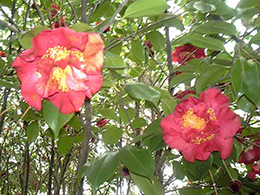In the park of Numazu Imperial Villa Memorial Park,
seasonal flowers bloom beautifully.
Introducing the best time to see flowers and information about flowers.
Western daffodils in full bloom in spring
From the middle of March to the end of March, Western narcissus flowers all at once on the site of the main residence of the Imperial Villa Memorial Park (just east of the restaurant "Horuma").
The bottom of the pine forest is magnificently decorated with yellow and white deep flowers.
Japanese daffodils add to the mood in the cold of the Imperial Villa, but Western daffodils will be in full bloom from the middle of March.
Although narcissus is a flower that tells spring in Europe, it is a plant suitable for the sandy area under the forest and suitable for the environment of the Imperial Villa.
About 30,000 narcissus plants of 38 varieties are planted here, and it is one of the most famous places in Japan in that Western narcissus can be viewed as a whole.
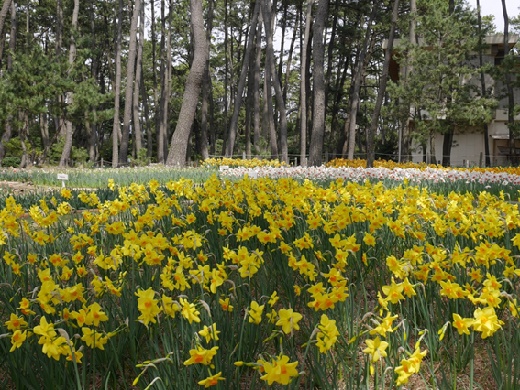
Characteristics of western daffodils
Narcissus is a bulbous plant that is roughly classified into 13 types depending on the shape of flowers.
The basic color of the flower is yellow or white, and the one with a particularly long secondary flower tube (trumpet part) in the middle of the flower is called a daffodil.
There are various differences depending on the variety, such as flower appearance, fragrance, and size.
How to raise
Since daffodils are bulbous plants, plant them in the fall and after flowering do not mow until the leaves are wilted.
From spring to early summer, you can increase the number of strains by digging up the bulbs every few years, performing a branching operation (separating the many lumps of bulbs), and planting them again in the fall.
A word from Hibiya Amenis
When the still-cold wind of early spring blows beneath the pine forest, the dull scent of daffodil surrounds you, and there are many daffodils in dignified standing form. The scientific name Narcissus is a “narcissist” with strong self-love, and the language of flowers is also self-love and conceit.
Narcissus is also one of the most beloved flowers in human history, and each one is fascinating both because of its gorgeousness as a group.
At the Imperial Villa, we produce the entire planting by combining different conditions such as flower color, shape, flower length, etc., and if you notice such ideas, the enjoyment of viewing will spread.
Supervised by Hibiya Amenis Co., Ltd.
Musashi Abashi, a flower in full bloom in spring
A perennial of the taro family. Grows in a moist part of the forest near the coast. From late March to late April, flowers with dark purple Buddha flames are attached.
The name comes from the fact that the shape of the Buddha flame bract is similar to "Abumi", a harness made in Musashi no Kuni.
It is scattered in the Urashima grass colony. Please find it.
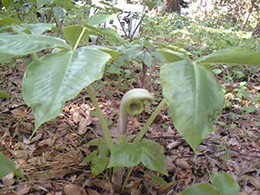
Cherry Blossoms in full bloom in spring
There are three types of cherry blossoms in the palace's mansion: Kawazu cherry blossoms and Hikan cherry blossoms.
The Hikanzakura, which is located next to the front of the main residence, is especially wonderful.
3月中旬から4月上旬にお楽しみ下さい。

Flowers in full bloom in spring
About 200 peaches of various colors such as red, pink and white are planted around the 1st and 2nd parking lots.
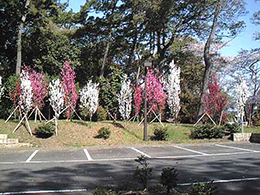
Urashima grass in full bloom in spring
Araceae. It is the name of the long string-like protrusions from the flower-like part (Fuen Bract), which is likened to Taro Urashima's fishing rod and thread.
Approximately 5,000 trees per 1,500 tsubo in Honjoen will bloom from late March to late April.
Although it is not a flashy flower, it seems that it is rare to find a place like a palace that grows on a flat land near the coast.
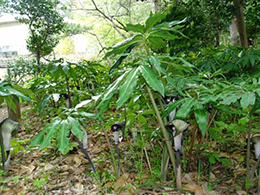
Characteristics of Urashima grass
Urasimasou is a bulbous plant that grows in forests near the coast, and you can also see clustered colonies in the Imperial Villa Memorial Park.
The mysterious shape is that the tip of the appendage that extends into the bract extends into a thin thread, and it seems that it was named after Taro Urashima hanging his fishing line.
There are large bulbs similar to taro in the basement, which grow buds in spring.
Eventually, spread out about 10 leaves like an umbrella and open the black-brown bracts.
This bract is called "Butsu Enho".
The original flower is known as a sex-changing plant that changes from a male flower to a female flower under the appendages, depending on the growth and nutritional conditions.
A word from Hibiya Amenis
There are various species of Tennansho, such as Pleurotus cornucopiae, found in Japan, but it is difficult to distinguish the shape and color of many species, and cultivation is not so common.
Please look for the unique figure that blooms under the forest of the Imperial Villa Memorial Park.
Supervised by Hibiya Amenis Co., Ltd.
Wisteria in full bloom in spring
A deciduous shrub of the legume vine. In May, three types of wisteria, Kokuryu, Daruma wisteria and Nagato, will make a tunnel on the approximately 90m wisteria rack in front of the Main Villa "History and Folklore Museum".
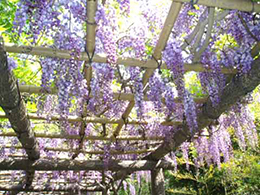
Features of wisteria
Wisteria grows a lot in the mountains, but because of the beauty of flowers, they have been planted for appreciation in various places since ancient times.
Even at the Imperial Villa Memorial Park, you can enjoy the magnificent wisteria flowers while strolling the dozens of meters of wisteria trough (the wisteria tunnel).
Supervised by Hibiya Amenis Co., Ltd.
Flowers in full bloom in summer "Hamanadeshiko"
A perennial plant of the family Dianthus. It grows in rocky areas on the coast.
Height about 40 cm. There are two types of royal residences, white and pink, and many flowers gather on the branches in summer.
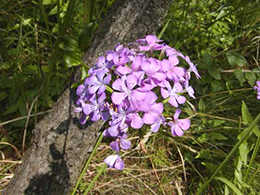
Flowers in full bloom in summer Hydrangea
It is a typical flower during the rainy season (June to July) and blooms flowers such as purple (magenta to violet) and white.
It is also called "seven changes" because the color of the flower changes variously depending on the pH concentration of the soil.
In the Imperial Villa, 2,300 strains of Hydrangea, Hydrangea, and Hydrangea are in full bloom. Also, there is one Kashiwaba Hydrangea strain.
Hydrangeas in the Imperial Villa Memorial Park are forming wonderful communities here and there.
From June to July, blue, purple and white hydrangeas such as Western Hydrangea and Gaku Hydrangea are in bloom, which is one of the features of the Imperial Villa Memorial Park.
When the hydrangea blooms, it often overlaps with the rainy season, but the most comfortable flower to see while holding an umbrella is hydrangea.

A word from Hibiya Amenis
Most of the hydrangeas that are currently planted for ornamental use originate in Japan and have been cultivated in Europe.
It is said that the color of the flower of hydrangea changes depending on the pH (acidity) of the soil, becoming "blue if it is acidic and red if it is alkaline". This is because PH affects whether aluminum is in the form of ions that are easily absorbed by the roots. If you want to make the flowers blue, give acidic fertilizer or alum containing aluminum. The color of the flower is different depending on the part of the same plant because of the difference in the amount of aluminum sent from the roots.
In addition, the flower color gradually changes with the passage of time from flowering. At first, it has a pale yellowish green color due to the chlorophyll contained in the flowers, and as it is decomposed, anthocyanins and auxiliary pigments are made, and they become red and blue.
Furthermore, as the days pass by, organic acids accumulate, and blue flowers also become reddish. This is due to flower aging and occurs independently of soil changes. Please enjoy the subtle color changes of Hydrangea in your residence.
Supervised by Hibiya Amenis Co., Ltd.
A perennial of the lily family. Native to Japan, it grows on the coast north of central Honshu. Early summer orange flowers bloom upwards. This name was given because there is a gap between the petals.
The sushi lily of the Imperial Villa is a sushi lily that grows naturally in Mihama, Toda district in the southern part of Numazu City, and was planted in the Nishi Attached House Garden after the merger.
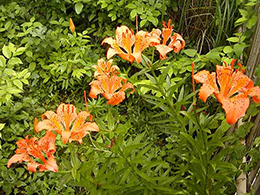
Flowers in full bloom in summer "Hamanasu"
Deciduous shrub of the Rosaceae family. It grows naturally on the sandy land on the coast north of central Honshu. There are thorns on the branches, and in the garden, from spring to summer, single-colored flowers with a strong scent of red and white, and double flowers of red are bloomed. In fact, it is elliptically shaped and ripens red.
Since "Hamanasu" is also the "mark" of Crown Princess Masako, we are selling the handkerchiefs and fukusa embroidered with this "mark" as original goods for the royal residence, which have been well received.
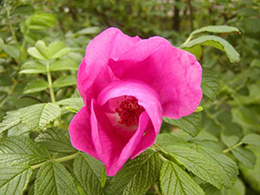
Flowers in full bloom in summer "Hamayu"
Another name: Hamaomoto. An evergreen perennial of the Amaryllidaceae that grows naturally on the coast of the warm district. Beach cotton scattered in the garden also grows flower stems from between leaves in summer and gives scented white flowers. It is also designated as a "flower" in Numazu-city

Characteristics of Hamayu
Hamayu is a perennial plant of the Limaceae family, which is also designated as a flower in Numazu City. It prefers well-drained and sunny places, and is a beach plant mainly found on warm beaches.
The grass looks like a thick cylindrical trunk to leaves like kelp that spread around the circumference, and the trunk-like thing is the roots of the leaves stacked in a fleshy cylindrical shape. Called stems, they are similar to the bulbs of Limulus or onions.
The flowering season is summer, with thick, straight stems extending upward from the middle of the leaves, and a large number of flowers are attached to the tips.
The flower has a long, white, six-pieceed flower coat on the tip of a short pattern. The roots of the petals come into contact with each other to form a cylinder, and the tips of the flowers warp apart. The flowers start to have a strong fragrance around sunset, and large moths come to the honey to carry pollen.
How to raise
It is necessary to grow in a sunny place. It's best to stay out of the shade from morning till night, and when the sun isn't enough, the leaves will go down and you won't feel well. Also, since it is vulnerable to cold and will die when exposed to frost, it will be potted except in warm regions.
Hamayu seedlings are best planted in April-August or November. In frosty areas, grow in pots.
In warm regions, Hamayu can be planted and planted. Select a place that will be exposed to the sun all day long and dig a planting hole with a diameter and depth of about 30 cm. And about 30% of the dug soil is mixed with mulch and planted.
A word from Hibiya Amenis
here may be many people who feel the arrival of summer as Hamayu blooms. As the name suggests, it blooms with a strong scent mainly in the evening. It blooms here and there in the Imperial Villa Memorial Park, so please take a leisurely walk in the park.
Garden fabric map
Flowers in full bloom in summer "Hamakanzo"
It is a lily plant and blooms in a sunny place along the Honjoenji Beach. The flowers are dark orange, trumpet-shaped doubles, and bloom vividly from mid June to mid July against the backdrop of the greenery of the garden.
There is also a similar species, the Nokanzo, where single flowers bloom from late July to early September.
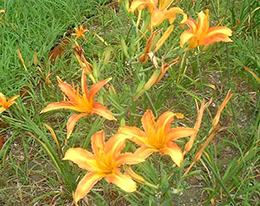
Flowers in full bloom in summer Jujube
A perennial plant of the family Amaryllidaceae. In the summer, the flower stalks of 50 to 70 cm in height are extended and several trumpet-shaped flowers open. The Natsuzuisen, which grows in front of the Honjoenji Bridge, are light pink and the number of flowers is increasing year by year.

Flowers in full bloom in summer Sunflower
An annual plant of the Asteraceae family. It grows to a height of about 2 meters and blooms quite large yellow and orange flowers. Nishi Sunflower The sunflowers that grow in the garden near the west coast have become representative flowers in summer.
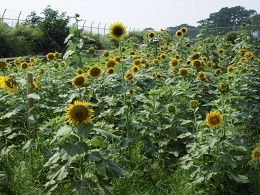
Features of sunflower
The Japanese name comes from the fact that the flowers turn around in the direction of the sun. <br>However, since this movement is accompanied by growth, it is only during the young period when the sun is growing that the sun actually moves, and the upper leaves of the stem of the young sunflower move so as to face the sun, and in the morning Turned east but turned west in the evening. It will soon rise after sunset and will turn east again before dawn. <br>This movement stops because the buds grow and the growth stops when the flowers open. In addition, this is the case when the variety that has only one flower on the stem apex receives unobstructed sunlight, and it does not necessarily occur in places where there are many flowers and obstructions to sunlight. <br>In Numazu Imperial Villa Memorial Park, it is planted around the west side lawn plaza on the coast and around the restaurant "Syume"".
How to raise
A word from Hibiya Amenis
It is mainly cultivated for food in the world, but as one of the flowers that enjoys the taste of summer, sunflowers with strong and large flowers are often planted. Although there are not many at Numazu Imperial Villa Memorial Park, please enjoy the sunflower landscape against the backdrop of a pine forest.
Flowers in full bloom in summer "Takasago lily"
Naturalized plant native to Taiwan. It blooms a white flower that looks like a lily of the valley. The leaves are thinner and the flowers are elongated compared to the lily of the valley, and they grow in clusters around the site of the former residence of the Gionjo Baba.
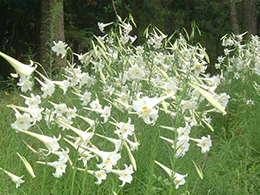
Flowers in full bloom in autumn "Hagi"
It is one of the most famous flowers in the autumn, and it is a flower familiar to Japanese people. In the Imperial Villa, it grows in high places on the site of the Honjoenji Air Defense trench.
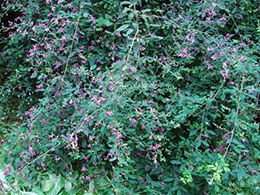
Flowers in full bloom in autumn "Isogiku"
A perennial of the Asteraceae family that grows from the southern Kanto region to the Tokai region and the beaches of the Izu Islands. In autumn, yellow flowers come along the coast of West SMall Villa.
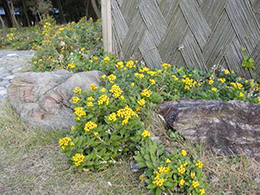
Features of Isogiku
Anemones grow naturally near the coast of warm regions such as the Chiba-Shizuoka coastline and the Izu region. As the name implies, it is a chrysanthemum that grows naturally on the beach. It is often cultivated in horticulture because it blooms brightly colored flowers in the season when the garden and flower beds tend to be lonely from autumn to late autumn. It is a perennial that blooms every year, and the main flowering period is from October to December. The image of small yellow flowers that bloom in tufts is different from the image of common chrysanthemums, but since it originally grows on the coast, it is resistant to severe sunlight and dryness.
Flowers in full bloom in autumn "Hamagiku"
A perennial of the Asteraceae family that grows on sunny beach dunes and cliffs. The leaves are spatula-shaped, gathering at the tips of the branches. In the autumn, clear and beautiful white flowers resembling Margaret bloom along the coast of West Small Villa.
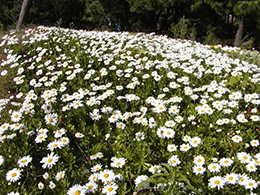
Features of Hamagiku
Hamagiku is a kind of so-called wild chrysanthemum, which grows mainly on the Pacific coast from Aomori prefecture to Ibaraki prefecture. The Izu region is located to the south of the original land, and it is thought that the current colony is not the original one, but it is still observed that it grows nice flowers in this area.
A flower produced by crossing this species with a French chrysanthemum is known as a shaster daisy and is often used in gardening.
How to raise
A word from Hibiya Amenis
Unlike the sea cucumber, the hollywood is a chrysanthemum that grows in the cool northern region. Unlike the sea cucumber, the hollywood is a chrysanthemum made from the cool northern region.
The genus name of Nipponanthemum, which is the scientific name for hollyhock, means "Japanese flower", and it is a genus that contains only one hollyhock.
Seeing it as a flower that has been displaying autumn along the coast of Japan for a long time, it gives a different feeling.
Supervised by Hibiya Amenis Co., Ltd.
Flowers in full bloom in Winter "Tsuwabuki"
Inner grass of Asteraceae. Many are scattered around the Imperial Villa. Tsuwabuki can often be seen on the coast of Izu. The villa of the Imperial Villa has relatively large leaves and good growth, yellow head flowers bloom lively, and fragrance is emitted in the garden. Please take a look at the wonderful Tsuwabuki.
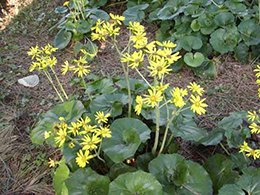
Characteristics of Tsuwabu
Tsuwabuki is an evergreen perennial found on the edge of forests, cliffs and forests along the sea. The leaves are leathery, shiny, round and about 20 cm in diameter.
The flower emerges from the center of the plant and a yellow flower with a diameter of around 3 cm, which resembles chrysanthemum with about 10 to 30 rings, blooms at the tip.
Many of the big leaves of the Tsuwabuki tree in the Imperial Villa are suitable for the growing environment, so you can enjoy the fragrance until about December.
Many horticultural varieties of Tsuwabuki are sold, and not only the flowers that bloom in autumn, but also the variegated leaves such as variegated leaves and lion leaves are varied, and it has been popular since ancient times as a plant that adds color to the courtyard.
How to raiseHow to raise
Grow in bright shade in the sun. The soil quality is irrelevant, but I prefer the well-drained land. Some varieties of variegated leaf gardens are better in the light shade. The soil grows well in common flowerbed flower culture soil, no special preparation is required. For garden planting, it is better to plant 10 to 20 cm of soil before planting.
A word from Hibiya Amenis
Tsuwabuki has many opportunities to be seen, and the impression of Japanese style is somewhat strong, but when it is enjoyed at home etc., it is a flower with good flowers even in the half shade, so it is a flower that suits shade garden well regardless of Western style.
However, the shape of the leaves is unique, so make sure that you don't feel any discomfort with the leaves.
When planting in the garden, use a simple green leaf or white spots to make it feel comfortable. Potted plants should be used for gardening plants with unusual leaves.
Supervised by Hibiya Amenis Co., Ltd.
Flowers in full bloom in Winter "Robai"
Although it has the name of ume, it is not a member of ume but a deciduous broad-leaved shrub of the family Astragalus. The name of Roubai is also said to be to protect yourself from the cold or because it looks like waxwork. It has a nice scent with yellow flowers scattered around the lands of the Nishi Attached House.
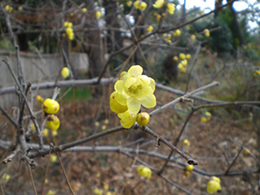
Flowers in full bloom in Winter Japanese Narcissus
From December to January, about 10,000 Japanese Narcissus are in full bloom as if they are waiting for spring, while receiving the strong westerly winter winds of the Suruga Bay along the coast of Nishi Attached Gardens.

Characteristics of Japanese Narcissus
Narcissus is roughly classified into 13 types depending on the shape of the flower. Narcissus originates from around the Mediterranean Sea in Europe, but Japanese narcissus companions have long been from Europe to China and Japan, and are characterized by a number of flowers on one stem and a strong scent.
Origin of Japanese Narcissus
It is said that Japanese Narcissus entered Japan in the early 15th century, and as a member of narcissus, they prefer warm climates. Since it blooms from December to January, you can see large-scale wildlands along the relatively warm and snow-free sea, such as Echizen Cape, Fukui Prefecture, Minamiizu, and Awaji Island.
The name came from the Japanese name of daffodil, which was used as it was in the Kamakura era, with the Chinese name “daffodil” being used as it was, and in particular, Chinese Narcissus were called yellow daffodils and Western NarcissusNarcissus were called daffodils.
How to raise
Japanese narcissus, which is often found as a cut flower around New Year's, is a bulbous plant, so plant it in autumn, and after flowering, do not trim it until the leaves wilt yellow. From spring to early summer, you can increase the number of strains by digging up the bulbs every few years, performing a branching operation (separating the many lumps of bulbs), and planting them again in the fall. Japanese narcissus, which is often found as a cut flower around New Year's, is a bulbous plant, so plant it in autumn, and after flowering, do not trim it until the leaves wilt yellow. From spring to early summer, you can increase the number of strains by digging up the bulbs every few years, performing a branching operation (separating the many lumps of bulbs), and planting them again in the fall.
A word from Hibiya Amenis
Japanese narcissus are planted here and there in the Imperial Villa Memorial Park, which gives it the atmosphere of this time. Please try to smell the scent gently. The scent of daffodils has a soothing effect.
Also, from late March, 30,000 bulbs of Western narcissus will bloom all at once. This makes the bottom of the pine forest gorgeous like a yellow or white carpet. The planting is produced by Hibiya Amenis. Please enjoy it
Supervised by Hibiya Amenis Co., Ltd.
Flowers in full bloom in Winter Plum
Plum is a deciduous tree in the rose family. The Imperial Palace has a plum garden commemorating the marriage of His Imperial Highness, and approximately 15 types of 140 plum trees bloom from mid January to late February.
On Saturdays, Sundays, and public holidays during this period, the tea ceremony service is offered for a fee as a Kanba tea ceremony.
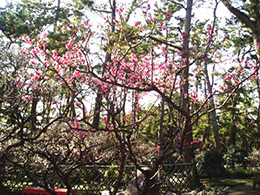
Characteristics of Plum"Ume"
Plum is known as the flower that appears most often in Manyoshu, and can be said to have been the most loved flower by the Japanese since ancient times.
The Numazu Imperial Villa's plums are also believed to have been seen annually by the imperial family during the period of the Imperial Villa.
>A word from Hibiya Amenis
"A fool that cuts cherry blossoms and a plum that doesn't cut plums"
It shows the precautions for cultivation while comparing cherry blossoms and plums, which are the representative flowers that bloom in early spring.
Cherry trees tend to rot from the cut edge if they are trimmed carelessly, so be careful when pruning. On the other hand, plum trees are highly resistant to pruning, and if they are not cut down considerably, not only will the branches grow and the tree shape will become cluttered and ruined, but the way the fruits will attach will also deteriorate.
As the flower buds move to the tip of the branch year after year, the branches that bear fruit usually die within a few years. For the purpose of harvesting fruits, it is necessary to update the branches regularly.
Supervised by Hibiya Amenis Co., Ltd.
Flowers in full bloom in Winter "Tsubaki"
About 300 Yabu camellia are planted and bloom in early January to early March.About 300 "Yabu Tsubaki" are planted and bloom in early January to early March.
